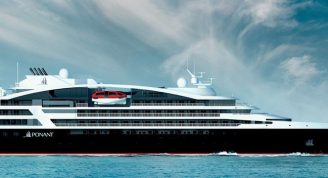Description
Join us on an expedition cruise from Reykjavík to Kangerlussuaq, following the same maritime course set by Norse settlers over a thousand years ago. Experience the diversity of East, South and West Greenland, from the bustling mini-metropolis of Nuuk to the spectacular icebergs of Sermilik all in one unique voyage!
Join us on a thrilling expedition cruise from Reykjavík, following the same maritime course set by Norse settlers over a thousand years ago. While the spectacular scenery of this region remains untouched, thankfully our purpose-built expedition ship offers significantly more comfort and style than a Viking longship! Our first destination is the rugged shores of East Greenland, an ancient land steeped in mythology and ancient Inuit tradition. Here we will experience Tunumiit culture in the bustling towns of Tasiilaq and Kuummiut, learn about Greenland’s fascinating modern history at Ikateq, and witness the icy majesty of Sermilikfjord, one of Greenland’s most spectacular sights. From here, we will chart a course for the glassy waters and perfect silence of Skjoldungen Fjord on Greenland’s southeast coast, after which we will sail through the magnificent strait of Prins Kristiansund, the glacier-lined channel separating Kap Farvel (Greenland’s southernmost point) from the mainland, before venturing deep into the fjords of South Greenland.
The lush green fields and rolling hills of South Greenland make it easy to see why the Norse gave the island the name it bears to this day – and why the Norse chose to settle in this green paradise. Here we will to visit the ancient remains of Brattahlíð, Erik the Red’s former farmstead in the small farming village of Qassiarsuk, and trek across to Igaliku, once the seat of the Norse Bishops of Greenland.
Following the magnificent coastline of Earth’s largest island, we will visit Nuuk, one of the smallest (but no less perfect) world capitals. With everything you would expect from a capital city, including skyscrapers, exceptional museums and boutique shopping, Nuuk still has a strong Greenlandic vibe; tiny traditional wooden houses sit in the shadow of glassy towers, and locals buy seal and whale meat at the city market. The city also has a few charming oddities- including the only traffic lights in Greenland!
From Nuuk, we will pass by the village of Kangaamiut, a town steeped in Greenlandic culture and tradition which sits on the edge of the a maze of fjords, islands, mountains and glaciers. In the afternoon, we will venture into the nearby Eternity Fjord to experience this astounding natural beauty.
Join us onboard Ocean Albatros for an enriching experience combining Nordic and Inuit culture and the natural wonders of the Arctic!








